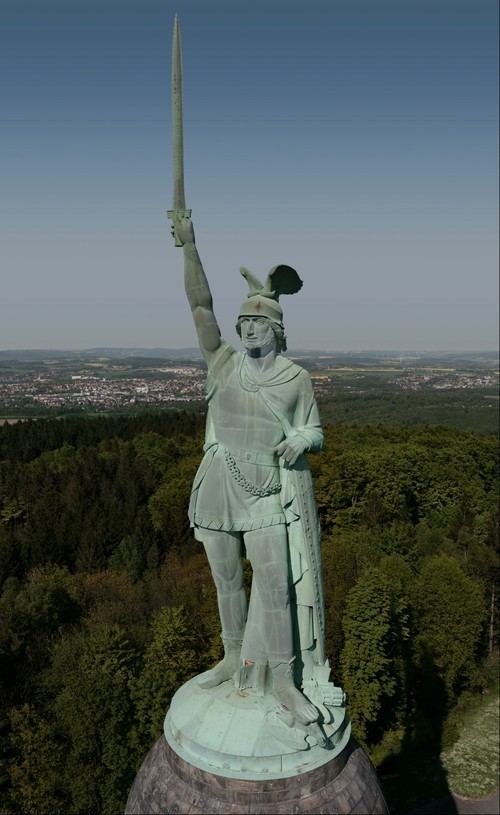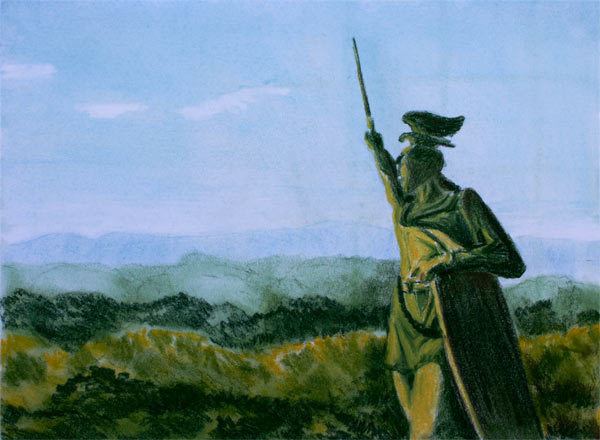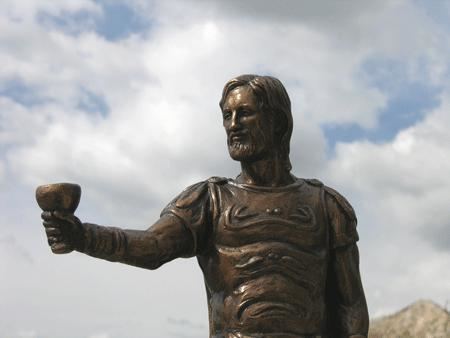Name Arminius Arminius Role Chief | Parents Segimer | |
 | ||
Similar People | ||
Arminius hw5 revolver
Arminius (German: Hermann; 18/17 BC – AD 21) was a chieftain of the Germanic Cherusci tribe who famously led an allied coalition of Germanic tribes to a decisive victory against three Roman legions in the Battle of the Teutoburg Forest in 9 AD. An auxiliary lieutenant to the Roman general Publius Quinctilius Varus, Arminius used his knowledge of Roman tactics to ambush and destroy the legions.
Contents
- Arminius hw5 revolver
- Archaeology hermann arminius part 1 of 3
- Name
- Biography
- Battle of the Teutoburg Forest
- Roman retaliation inter tribal conflicts and death
- Legacy
- Rome
- Old Norse sagas
- German nationalism
- Site of the battle
- Alternative theories on the battles location
- In popular culture
- References

The defeat at Teutoburg would precipitate the Roman Empire's permanent strategic withdrawal from Magna Germania, and the Romans made no more concerted attempts to conquer and hold Germania beyond the Rhine river. Modern historians have regarded Arminius' victory as "Rome's greatest defeat" and one of the most decisive battles in history.

During the unification of Germany in the 19th century, Arminius was hailed by nationalists as a symbol of German unity and freedom, and was celebrated as a national hero in his German name Hermann. Following World War II, however, schools often shunned the topic since it had become associated with the militaristic nationalism of the Third Reich, and many modern Germans have not heard about Arminius. The 2000th anniversary of the battle was not commemorated by the German government.

Archaeology hermann arminius part 1 of 3
Name

The etymology of the Latin name Arminius is unknown. Marcus Velleius Paterculus, in his Historiae, mentions him as "Arminius, the son of Sigimer, a prince of [the German] nation" and states he "attained the dignity of equestrian rank". Due to Roman naming conventions of the time, it is likely Arminius is an adopted name granted to him upon citizenship, or otherwise not his Cheruscan name.

The origin of the name Hermann dates from the 16th century, possibly first by Martin Luther. In German, Arminius is traditionally known as Hermann der Cheruskerfürst ("Hermann the Cheruscan Prince"). Hermann is also German for "Man of War", coming from the Old High German heri- "war", and man, "man".
Biography
Arminius, born in 18 or 17 BC in Germania, was son of the Cheruscan chief Segimerus (German: Segimer) and trained as a Roman military commander alongside his younger brother Flavus. He had lived in Rome as a hostage in his youth, where he had served in the Roman army between 1 and 6 AD, and had received a military education and obtained Roman citizenship as well as the status of equite before returning to Germania and driving the Romans out.
Battle of the Teutoburg Forest
Around the year AD 4, Arminius assumed command of a Cheruscan detachment of Roman auxiliary forces, probably while fighting in the Pannonian wars on the Balkan peninsula. He returned to northern Germania in AD 7 or 8, where the Roman Empire had established secure control of the territories just east of the Rhine, along the Lippe and Main rivers, and was now seeking to extend its hegemony eastward to the Weser and Elbe rivers, under Publius Quinctilius Varus, a high-ranking administrative official appointed by Augustus as governor. Arminius began plotting to unite various Germanic tribes to thwart Roman efforts to incorporate their lands into the empire. Between 6 and 9 AD, the Romans were forced to move eight of eleven legions present in Germania east of the Rhine river to crush a rebellion in the Balkans, leaving Varus with only three legions to face the Germans. Additional two legions, under the command of Lucius Nonius Asprenas were stationed in Moguntiacum. This represented the perfect opportunity for Arminius to defeat Varus.
In the autumn of AD 9, the 25-year-old Arminius brought to Varus a fake report of rebellion in northern Germany. He persuaded Varus to divert the three legions under his command (composed of the 17th, 18th and 19th legions, plus three cavalry detachments and six cohorts of auxiliaries) from the march to winter quarters to suppress the rebellion. Varus and his legions marched right into the trap that Arminius had set for them near Kalkriese, the Battle of the Teutoburg Forest. Arminius's tribe, the Cherusci, and their allies the Marsi, Chatti, Bructeri, Chauci, and Sicambri (five out of at least fifty Germanic tribes at the time) ambushed and annihilated Varus's entire army, totaling over 20,000 men. Recent archaeological finds show the long-debated location of the three-day battle was almost certainly near Kalkriese Hill, about 20 km north of Osnabrück. When defeat was certain, Varus committed suicide by falling on his sword. Arminius's success in destroying three entire legions and driving the Romans out of Germany was one of the most devastating defeats Rome suffered in its history, and a high point of Germanic power for centuries. Roman attempts to reconquer Germania failed although they managed to break Arminius's alliance.
Roman retaliation, inter-tribal conflicts, and death
After the battle, the Germans quickly annihilated every trace of Roman presence east of the Rhine. The vastly outnumbered Roman garrison of Aliso (modern day Haltern am See), under the command of the prefect Lucius Cedicius, inflicted massive losses on the Germans before retreating into Gaul, resisting long enough for Lucius Nonius Asprenas to organize the Roman defense on the Rhine and Tiberius to arrive with a new army. This prevented Arminius from crossing the Rhine and invading Gaul.
Between 14 and 16 AD, Germanicus launched punitive operations into Germany, twice defeating Arminius (according to Tacitus): first in the Battle of the Weser River and later near the Wall of the Angrivarii. Arminius also faced opposition from his father-in-law and other pro-Roman Germanic leaders. In AD 15, Roman troops managed to recapture one of the three legionary eagles lost in the Battle of the Teutoburg Forest. In AD 16, a second eagle was retrieved. Tiberius denied the request of Germanicus to launch an additional campaign for AD 17, however, having decided the frontier with Germania would stand at the Rhine river. Instead, he offered Germanicus the honor of a triumph for his two victories. The third Roman eagle was recovered in AD 41 by Publius Gabinius, under the emperor Claudius.
With the end of the Roman threat, a war broke out between Arminius and Marbod, king of the Marcomanni. It ended with Marbod fleeing to Ravenna and Roman protection, but Arminius failed to break into the "natural fortification" of Bohemia, and the war ended in stalemate.
In AD 19, Germanicus died in Antioch under circumstances which led many to believe he had been poisoned by his opponents. Arminius suffered death two years later, in AD 21, murdered by opponents within his own tribe who felt that he was becoming too powerful. Tiberius allegedly had refused an earlier offer from a Chatti nobleman to poison Arminius: "It was not by secret treachery but openly and by arms that the people of Rome avenged themselves on their enemies."
Roman attempts to reconquer Germany failed although the Romans inflicted several defeats on the Germans.
Arminius's victory against the Roman legions in the Teutoburg Forest had a far-reaching effect on the subsequent history of both the ancient Germanic peoples and on the Roman Empire. The Romans were to make no more concerted attempts to conquer and permanently hold Germania beyond the river Rhine and the Agri Decumates. Modern historians have regarded Arminius's victory as "Rome's greatest defeat" and one of the most decisive battles in history. During the unification of Germany in the 19th century, Arminius became hailed as a symbol of German unity and freedom.
Legacy
Arminius had married a princess named Thusnelda, whose name is preserved only by Strabo. She was captured by the Romans while pregnant, so her son Thumelicus, grew up in Roman captivity. Tacitus tells us he had an unusual story, which the historian promises to tell, but it has been lost to us.
Rome
In the accounts of his Roman enemies, Arminius is highly regarded for his military leadership skills and as a defender of the liberty of his people. Based on these records, the story of Arminius was revived in the 16th century with the recovery of the histories of Tacitus, who wrote in his Annales II, 88:
Arminius, without doubt Germania's liberator, who challenged the Roman people not in its beginnings like other kings and leaders, but in the peak of its empire; in battles with changing success, undefeated in the war.
Arminius was not the only reason for Rome's change of policy towards Germania. Politics also played a factor; emperors could rarely trust a large army to a potential rival, though Augustus had enough family members to wage his wars. Also, Augustus, in his 30-year reign, had annexed many territories still at the beginning of the process of romanization.
Tiberius, successor of Augustus, decided that Germania was a far less developed land, possessing few villages, with only a small food surplus, and therefore was not currently important to Rome. It would require a commitment too burdensome for the imperial finances and for excessive expenditure of military force for a new achievement.
Modern scholars have pointed out that the Rhine was a more practical boundary for the Roman Empire than any other river in Germania. Armies on the Rhine could be supplied from the Mediterranean Sea via the Rhône, Saône and Mosel, with a brief area of portage. Armies on the Elbe, however, would have to have been supplied by extensive overland routes or by ships travelling the hazardous Atlantic. Economically, the Rhine already had towns and sizable villages at the time of the Gallic conquest. The Rhine was significantly more accessible from Rome and better equipped to supply sizeable garrisons than the regions beyond.
Rome would control Germania by appointing client kings, which was cheaper than military campaigns. Rome chose no longer to rule directly in Germania east of the Rhine and north of the Danube; Rome preferred to exert indirect influence through client kings, so Italicus, nephew of Arminius, was appointed king of the Cherusci; Vangio and Sido became vassal princes of the powerful Suebi, etc.
If indirect methods proved insufficient to control the Germanic tribes beyond the Rhine, Roman Emperors would lead devastating punitive campaigns deep into Germania. One of them, led by the Roman emperor Maximinus Thrax, resulted in a Roman victory in AD 235 at the Battle at the Harzhorn Hill, which is located in the modern German state of Lower Saxony, east of the Weser river, between the towns of Kalefeld and Bad Gandersheim.
Old Norse sagas
In the early 19th century, attempts were made to show that the story of Arminius and his victory may have lived on in the Old Norse sagas, in the form of the dragon slayer Sigurd of the Völsunga saga and the Nibelungenlied. An Icelandic account states that Sigurd "slew the dragon" in the Gnitaheidr—today the suburb Knetterheide of the city of Bad Salzuflen, located at a strategic site on the Werre river which could very well have been the point of departure of Varus's legions on their way to their doom in the Teutoburg Forest. Also one of the foremost Scandinavian scholars of the 19th century, Guðbrandur Vigfússon, identifies Sigurd as Arminius. This educated guess was also picked up by Otto Höfler, who was a prominent National Socialist academic in World War II.
German nationalism
In Germany, the name Arminius was interpreted as reflecting the name Hermann by Martin Luther, who saw Arminius as a symbol of the German people and their fight against Rome. Hermann der Cheruskerfürst became an emblem of the revival of German nationalism fueled by the Napoleonic Wars in the 19th century.
In 1808, Heinrich von Kleist wrote the play Die Hermannsschlacht but with Napoleon's victory at Wagram it remained in manuscript, being published in 1821 and not staged until 1860. The play has been revived repeatedly at moments propitious for raw expressions of National Romanticism and was especially popular during the Third Reich.
In 1839, construction was started on a massive statue of Arminius, known as the Hermannsdenkmal, on a hill near Detmold in the Teutoburg Forest; it was finally completed and dedicated during the early years of the Second German Empire in the wake of the German victory over France in the Franco-Prussian War of 1870–1871. The monument has been a major tourist attraction ever since, as has The Hermann Heights Monument, a similar statue erected in New Ulm, Minnesota in the United States in 1897.
The Hermann Heights monument was erected by the Sons of Hermann, a fraternal organization formed by German Americans in New York City in 1840 and named for Hermann the Cheruscan that during the 19th century flourished in American cities with large populations of German origin. Hermann, Missouri, a town on the Missouri River founded in the 1830s and incorporated in 1845, was also named for Arminius.
Following World War II Arminius became a less known figure among (West-)Germans and many schools shunned away from teaching the subject in any detail due to its previous association with nationalism. There was however a somewhat different perception in East Germany and West Germany. In East Germany Arminius based on a Marxist reading of history, he came to be seen as a revolutionary figure of sorts leading German tribes in a fight against the Roman slaveholder society (Sklavenhaltergesellschaft). Moreover in the context of the Cold War Arminius became a symbol for socialism with Rome being a symbol for the capitalist United States as an oppressive empire.
The 2,000 year anniversary of the battle was not commemorated by the German government. According to Der Spiegel: "The old nationalism has been replaced by an easy-going patriotism that mainly manifests itself at sporting events like the soccer World Cup." The German Bundesliga football-club DSC Arminia Bielefeld is named after Arminius.
Site of the battle
For almost 2,000 years, the site of the battle was unidentified. After World War II, it was taught that the story was only a legend with no real historical value, despite the Roman historical accounts, until a discovery by a novice treasure hunter (see below) proved the story of 'Hermann' to be real.
The main clue to its location was an allusion to the saltus Teutoburgiensis in section i.60–62 of Tacitus' Annals, an area "not far" from the land between the upper reaches of the Lippe and Ems Rivers in central Westphalia. During the 19th century, theories as to the site abounded, and the followers of one theory successfully argued for a long wooded ridge called the Osning, near Bielefeld. This was then renamed the Teutoburg Forest.
Late 20th-century research and excavations were sparked by finds by a British amateur archaeologist Major Tony Clunn, who was casually prospecting at Kalkriese Hill (52°26′29″N 8°08′26″E) with a metal detector in the hope of finding "the odd Roman coin". He discovered coins from the reign of Augustus (and none later), and some ovoid leaden Roman sling bolts. Kalkriese is a village administratively part of the city of Bramsche, on the north slope fringes of the Wiehen, a ridge-like range of hills in Lower Saxony north of Osnabrück. This site, some 100 km north west of Osning, was first suggested by the 19th-century historian Theodor Mommsen, renowned for his fundamental work on Roman history.
Initial systematic excavations were carried out by the archaeological team of the Kulturhistorisches Museum Osnabrück under the direction of Professor Wolfgang Schlüter from 1987. Once the dimensions of the project had become apparent, a foundation was created to organise future excavations and to build and operate a museum on the site, and to centralise publicity and documentation. Since 1990 the excavations have been directed by Susanne Wilbers-Rost.
Excavations have revealed battle debris along a corridor almost 24 km (15 mi) from east to west and little more than a mile wide. A long zig-zagging wall of peat turves and packed sand had apparently been constructed beforehand: concentrations of battle debris in front of it and a dearth behind it testify to the Romans' inability to breach the Germans' strong defence. Human remains appear to corroborate Tacitus' account of the Roman legionaries' later burial. Coins minted with the countermark VAR, distributed by Varus, also support the identification of the site. As a result, Kalkriese is now perceived to be the site of part of the battle, probably its conclusive phase.
The Varusschlacht Museum and Park Kalkriese includes a large outdoor area with trails leading to a re-creation of part of the earthen wall from the battle and other outdoor exhibits. An observation tower, which holds most of the indoor exhibits, allows visitors to get an overview of the battle site. A second building includes the ticket center, museum store and a restaurant. The museum houses a large number of artifacts found at the site, including fragments of studded sandals legionaries lost, spearheads, and a Roman officer's ceremonial face-mask, which was originally silver-plated.
Alternative theories on the battle's location
Although the majority of evidence has the battle taking place east and north of Osnabrück and the end at Kalkriese Hill, some scholars and others still adhere to older theories. Moreover, there is controversy among Kalkriese adherents themselves as to the details. The German historians Peter Kehne and Reinhard Wolters believe that the battle was probably in the Detmold area, and that Kalkriese is the site of one of the battles in AD 15. This theory is, however, in contradiction to Tacitus' account.
A number of authors, including the archaeologists Susanne Wilbers-Rost and Günther Moosbauer, historian Ralf Jahn, and British author Adrian Murdoch (see below), believe that the Roman army approached Kalkriese from roughly due east, from Minden, North Rhine-Westphalia, not from south of the Wiehen Hills (i.e., from Detmold). This would have involved a march along the northern edge of the Wiehen Hills, and the army would have passed through flat, open country, devoid of the dense forests and ravines described by Cassius Dio. Historians such as Gustav-Adolf Lehmann and Boris Dreyer counter that Cassius Dio's description is too detailed and differentiated to be thus dismissed.
Tony Clunn (see below), the discoverer of the battlefield, and a "southern-approach" proponent, believes that the battered Roman army regrouped north of Ostercappeln, where Varus committed suicide, and that the remnants were finally overcome at the Kalkriese Gap. Peter Oppitz argues for a site in Paderborn, some 120 km (75 mi) south of Kalkriese. Based on a reinterpretation of the writings of Tacitus, Paterculus, and Florus and a new analysis of those of Cassius Dio, he proposes that an ambush took place in Varus's summer camp during a peaceful meeting between the Roman commanders and the Germans.
